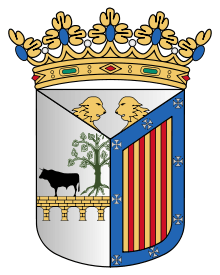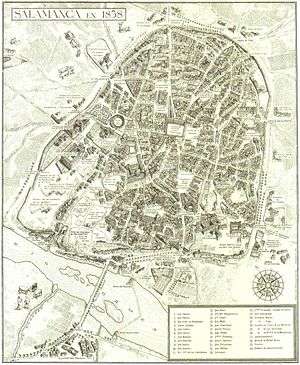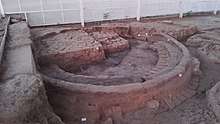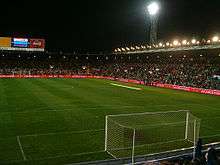Salamanca
Salamanca (/ˌsæləˈmæŋkə/ SAL-ə-MANK-ə, Spanish: [salaˈmaŋka]) is a city in western Spain that is the capital of the Province of Salamanca in the community of Castile and León. The city lies on several hills by the Tormes River. Its Old City was declared a UNESCO World Heritage Site in 1988. As of 2018, the municipality has a population of 143,978.
Salamanca | |||||||||||||||||||||
|---|---|---|---|---|---|---|---|---|---|---|---|---|---|---|---|---|---|---|---|---|---|
.jpg) | |||||||||||||||||||||
 Flag  Coat of arms | |||||||||||||||||||||
 Salamanca Location of Salamanca in Spain  Salamanca Salamanca (Castile and León)  Salamanca Salamanca (Europe) | |||||||||||||||||||||
| Coordinates: 40°58′N 5°40′W | |||||||||||||||||||||
| Country | Spain | ||||||||||||||||||||
| Autonomous community | Castile and León | ||||||||||||||||||||
| Province | Salamanca | ||||||||||||||||||||
| Area | |||||||||||||||||||||
| • Total | 38.6 km2 (14.9 sq mi) | ||||||||||||||||||||
| Elevation | 802 m (2,631 ft) | ||||||||||||||||||||
| Population (2018)[1] | |||||||||||||||||||||
| • Total | 143,978 | ||||||||||||||||||||
| • Density | 3,700/km2 (9,700/sq mi) | ||||||||||||||||||||
| Time zone | UTC+1 (CET) | ||||||||||||||||||||
| • Summer (DST) | UTC+2 (CEST) | ||||||||||||||||||||
| Area code(s) | 34 (Spain) + 923 (Salamanca) | ||||||||||||||||||||
| Website | www.salamanca.es | ||||||||||||||||||||
| |||||||||||||||||||||
It is one of the most important university cities in Spain and supplies 16% of Spain's market for the teaching of the Spanish language.[2][3] Salamanca attracts thousands of international students.[4]
The University of Salamanca, which was founded in 1218, is one of the oldest universities in Spain and the third oldest western university, but the first to be given its status by the Pope Alexander IV who gave universal validity to its degrees.[5] With its 30,000 students, the university is, together with tourism, a primary source of income in Salamanca. It is on the Via de la Plata path of the Camino de Santiago.
Geography
Location
The city lies on the banks of the Tormes river, a major left-bank tributary of the Douro. It is also part of the Vía de la Plata, an ancient S–N path in Western Spain.[6] It is situated approximately 200 kilometres (120 miles) west of the Spanish capital Madrid[7] and 80 km (50 mi) east of the Spanish-Portuguese border.
Climate
With an altitude of over 800 meters, Salamanca has a warm-summer Mediterranean climate (Csb) according to the Köppen climate classification, with some cold semi-arid climate (BSk) climatic influences, resulting in large diurnal temperature variations, a slightly hotter summer and colder winter, and nearly-semi-arid levels of precipitation. Nearly all of the year's precipitation falls outside of the summer, with upticks at the end of the spring and during the winter; snow is not common, with only a few days per year on average seeing snow.[8]
| Climate data for Salamanca Airport 790 m (2,590 ft) (1981-2010) | |||||||||||||
|---|---|---|---|---|---|---|---|---|---|---|---|---|---|
| Month | Jan | Feb | Mar | Apr | May | Jun | Jul | Aug | Sep | Oct | Nov | Dec | Year |
| Record high °C (°F) | 19.8 (67.6) |
25.0 (77.0) |
25.8 (78.4) |
31.0 (87.8) |
34.5 (94.1) |
38.6 (101.5) |
39.8 (103.6) |
41.0 (105.8) |
39.0 (102.2) |
31.0 (87.8) |
24.8 (76.6) |
19.7 (67.5) |
41.0 (105.8) |
| Average high °C (°F) | 8.6 (47.5) |
11.2 (52.2) |
14.9 (58.8) |
16.5 (61.7) |
20.6 (69.1) |
26.6 (79.9) |
30.0 (86.0) |
29.5 (85.1) |
25.1 (77.2) |
18.9 (66.0) |
12.8 (55.0) |
9.4 (48.9) |
18.7 (65.7) |
| Daily mean °C (°F) | 4.0 (39.2) |
5.5 (41.9) |
8.3 (46.9) |
10.1 (50.2) |
14.0 (57.2) |
18.8 (65.8) |
21.5 (70.7) |
21.1 (70.0) |
17.6 (63.7) |
12.6 (54.7) |
7.9 (46.2) |
4.9 (40.8) |
12.2 (54.0) |
| Average low °C (°F) | −0.7 (30.7) |
−0.2 (31.6) |
1.7 (35.1) |
3.8 (38.8) |
7.3 (45.1) |
11.0 (51.8) |
12.9 (55.2) |
12.6 (54.7) |
10.0 (50.0) |
6.4 (43.5) |
2.4 (36.3) |
0.4 (32.7) |
5.6 (42.1) |
| Record low °C (°F) | −15.6 (3.9) |
−20.0 (−4.0) |
−9.0 (15.8) |
−5.5 (22.1) |
−2.3 (27.9) |
2.0 (35.6) |
5.0 (41.0) |
4.5 (40.1) |
0.4 (32.7) |
−4.7 (23.5) |
−10.6 (12.9) |
−12.0 (10.4) |
−20.0 (−4.0) |
| Average precipitation mm (inches) | 30 (1.2) |
25 (1.0) |
21 (0.8) |
38 (1.5) |
47 (1.9) |
29 (1.1) |
11 (0.4) |
12 (0.5) |
32 (1.3) |
46 (1.8) |
40 (1.6) |
42 (1.7) |
372 (14.6) |
| Average precipitation days | 6 | 5 | 5 | 7 | 8 | 4 | 2 | 2 | 4 | 7 | 7 | 7 | 64 |
| Average snowy days | 2 | 2 | 1 | 1 | 0 | 0 | 0 | 0 | 0 | 0 | 1 | 1 | 7 |
| Average relative humidity (%) | 82 | 73 | 63 | 62 | 59 | 52 | 47 | 51 | 59 | 71 | 79 | 83 | 65 |
| Mean monthly sunshine hours | 118 | 154 | 211 | 224 | 265 | 317 | 358 | 330 | 251 | 183 | 130 | 104 | 2,667 |
| Source: Agencia Estatal de Meteorología (1981-2010 climatology)[9] | |||||||||||||
History
The city was founded in the pre-Ancient Rome period by the Vaccaei (a Celtic tribe), or the Vettones (a Celtic or pre-Celtic indo-European tribe), as one of a pair of forts to defend their territory near the Duero river. In 220 BC Hannibal laid siege to the city and captured it.[11] With the fall of the Carthaginians to the Romans, the city of Helmantica, as it was known, began to take more importance as a commercial hub in the Roman Hispania due to its favorable location. Salamanca lay on a Roman road, known as the Vía de la Plata, which connected it with Emerita Augusta (present day Mérida) to the south and Asturica Augusta (present-day Astorga) to the north. Its Roman bridge dates from the 1st century, and was a part of this road.
With the fall of the Roman Empire, the Alans established in Lusitania, and Salamanca was part of this region. Later the city was conquered by the Visigoths and included in their territory. The city was already an episcopal see, and signatures of bishops of Salamanca are found in the Councils of Toledo.
Salamanca surrendered to the Umayyad invasion, led by Musa bin Nusair, in 712 AD. The area from this city on the Tormes River north to the Duero River then became the main battlefield between the Christian kingdoms and the Muslim Al-Andalus rulers. The constant fighting of the Kingdom of León, later reinforced by union with the Kingdom of Castile, against the Caliphate depopulated Salamanca and reduced it to an unimportant settlement. After the battle of Simancas (939) the Christians resettled this area. After the 1085 seizure of Toledo by Alfonso VI of León and Castile, the definitive resettlement of the city took place. Raymond of Burgundy, instructed by his father-in-law Alfonso VI of León, led a group of settlers of various origins in 1102.
One of the most important moments in Salamanca's history was the year 1218, when Alfonso IX of León granted a royal charter to the University of Salamanca, although formal teaching had existed at least since 1130. Soon it became one of the most significant and prestigious academic centres in Europe.

The 15th century was plagued by social conflict and tensions among the urban elites (a complex development, often oversimplified as an infighting between bandos), with occasional outbursts of grave episodes of violence, conveying a chronic feeling of insecurity.[12]
The late 15th century population has been tentatively estimated at 15,000–25,000.[13] By the turn of the 16th century most of the population dwelled at the right (north) bank of the Tormes, with a small arrabal in the south bank inhabited by roughly 300 people.[14]
During the 16th century, the city reached its height of splendour (around 6,500 students and a total population of 24,000). During that period, the University of Salamanca hosted the most important intellectuals of the time; these groups of mostly-Dominican scholars were designated the School of Salamanca. The juridical doctrine of the School of Salamanca represented the end of medieval concepts of law, and founded the fundamental body of the ulterior European law and morality concepts, including rights as a corporeal being (right to life), economic rights (right to own property) and spiritual rights (rights to freedom of thought and rights related to intrinsic human dignity).
In 1551, the Holy Roman Emperor Charles V ordered an inquiry to find out if the science of Andreas Vesalius, physician and anatomist, was in line with Catholic doctrine. Vesalius came to Salamanca that same year to appear before the board and was acquitted.
Salamanca suffered the general downturns of the Kingdom of Castile during the 17th century, but in the 18th century it experienced a rebirth. In this period, the new baroque cathedral and main square (Plaza Mayor) were finished.
In the Peninsular War theatre of the Napoleonic Wars, the Battle of Salamanca took place on 22 July 1808 in the nearby fields of Arapiles, in which an Anglo-Portuguese Army led by Wellington decisively defeated the French army of Marmont. The western quarter of Salamanca was seriously damaged by cannon fire. The battle which raged that day is famous as a defining moment in military history [15] and thirteen thousand men were killed or wounded in the space of only a few short hours.

During the devastating Spanish Civil War (1936–39) the city quickly went over to the Nationalist side and was temporarily used as the de facto headquarters for the rebel faction. Francisco Franco was proclaimed Generalissimo on 21 September 1936 while at the city. In April 1937, the FET y de las JONS, the single party of the ensuing dictatorship, was created via a Unification Decree issued at the city upon the merging of the fascist Falange and the traditionalist carlists. The Nationalists soon moved most of the administrative premises to Burgos, which, being more central, was better suited for this purpose. However, some administrative apparatus, Franco's headquarters (located at the Palacio Episcopal, next to the Old Cathedral) and the military commands stayed in Salamanca, along with the German and Italian fascist delegations, making it the de facto Nationalist capital and centre of power during the entire civil war.[16][17] Like much of fervently Catholic and largely rural Leon and Old Castile regions, Salamanca was a staunch supporter of the Nationalist side and Francisco Franco's regime for its long duration.
In 1988, the old city was declared a UNESCO World Heritage Site. In 1998, it was declared a European Capital of Culture for year 2002 (shared with Bruges). During 14 and 15 October 2005, it hosted the XV Ibero-American Summits of Heads of State and Governments.
Since 1996, Salamanca has been the designated site of the archives of the Spanish Civil War (Archivo General de la Guerra Civil Española). The original documents were assembled by the Francoist regime, selectively obtained from the administrative departments of various institutions and organizations during the Spanish Civil War as a repressive instrument used against opposition groups and individuals.[18] The socialist government moved the Catalan part of the archive to Barcelona in 2006 despite opposition from the local authorities and popular protests.
University

The University of Salamanca was founded in 1134 and in 1218 it was given the royal charter of foundation ("Estudio General") by Alfonso IX of León. It was the first university to receive the title of "University" in 1254. Under the patronage of the learned Alfonso X, its wealth and reputation greatly increased (1252–1282), and its schools of canon law and civil law attracted students even from the Universities of Paris and Bologna. In the 16th century, the city's fortunes depended on those of the University. About the time Christopher Columbus was lecturing there on his discoveries, Hernán Cortés took classes at Salamanca, but returned home in 1501 at age 17, without completing his course of study. (About ten years later the conquistador Francisco Vásquez de Coronado was born in Salamanca.)
Economy
The city's economy is dominated by the university and tourism, but other sectors including agriculture and livestock rearing along with construction and manufacturing are also significant. Not surprisingly, in December 2007 83% of the working population, equivalent to 55,838, were employed in the service sector.[19]
Industry
Industrial activity accounted for 5% of the working population, or 3,340 workers employed over 360 businesses.[19] Two of the largest businesses, both of them numbered among the largest 100 enterprises in the region, are the veterinary vaccine manufacturer "Laboratorios Intervet", and the fertilizer specialist manufacturers S.A. Mirat, which is the city's oldest industrial company, having been established originally as a starch factory in 1812.[20]
Transport
.jpg)
Road
Highways
- A50: Autovía de la Cultura: Ávila - Salamanca
- A62: Autovía de Castilla: Burgos - Valladolid - Salamanca - Ciudad Rodrigo.
- A66: Autovía Ruta de la Plata: Gijón - Oviedo - Mieres - Puerto de Pajares - León - Benavente - Zamora - Salamanca - Béjar - Plasencia - Mérida - Sevilla.
- SA-11: North access to Salamanca.
- SA-20: South access to Salamanca.
.jpg)
Other roads
- N-501: Ávila - Peñaranda de Bracamonte - Salamanca.
- N-620: Burgos - Venta de Baños - Valladolid - Tordesillas - Salamanca - Ciudad Rodrigo - Portugal.
Airport
Salamanca Airport, located in the military base of Matacán, is located about 14 km (9 mi) east of the city.
Culture and sports
The Old City of Salamanca was declared a UNESCO World Heritage Site in 1988.[22] In 2002, Salamanca shared the title of European Capital of Culture with Bruges. In 2005, Salamanca celebrated the 250th anniversary of the construction of the Plaza Mayor with a number of European events (Plaza Mayor de Europa).
Festivals
Holy Week
The Holy Week in Salamanca (Semana Santa) is the most well-known feast in the city. Salamanca is renowned for the solemn and sober processions celebrated during Holy Week. 16 confraternities, 10,000 brothers or "cofrades", 50 floats or "pasos" celebrate the Passion of Christ with 20 processions and thousands of followers, tourist and visitors.
Some of the celebrations have been performed for centuries. The confraternities carry artistic pasos created by important Spanish artists such as Luis Salvador Carmona, Alejandro Carnicero or Mariano Benlliure. in 2003 the Semana Santa of Salamanca obtained the official declaration of International Touristic Interest.[23]
Other
Salamanca is also famous throughout Spain and the rest of Europe for its celebrations of "Nochevieja Universitaria," loosely translated as "University New Year".[24] It is usually held on the Thursday of the last week of school in December and two weeks before the real New Year's Eve. On this day, students congregate in the Plaza Mayor, Salamanca to watch free performances and take part in the countdown to midnight.
Sports
From 1923 onward, "Los Charros,” formally the Union Deportiva Salamanca, were the Salamanca football team. In 2013, the club went bankrupt and its activities were abandoned.[25] After its dissolution, some managers of the entity decided to refound the farm team to continue competing, maintaining the legacy of the historic club. Thus they created the Club de Fútbol Salmantino.
The first high jump over 8 feet (2.44 m) was made in Salamanca, by Javier Sotomayor in 1993. His jump, of 2.45 m (8 feet 0.46 inch), is still the world record in the event.
Local teams
- Salamanca CF, football team
- Unionistas de Salamanca CF, football team.
- CB Avenida, basketball team.
Cinema
The picturesque setting provided by the city has been featured in several films, including Ridley Scott's 1492: Conquest of Paradise and Miloš Forman's Goya's Ghosts. Salamanca was also the setting for the 2008 political thriller Vantage Point, although the movie was almost exclusively filmed in Mexico.
Sister cities and twin towns
Notable people
- Fernando Gallego (1440–1507), Spanish painter
- Miguel de Unamuno (1864–1936), writer, professor of Greek, and rector of the university
- José María Lamamié de Clairac y Colina (1887-1956), politician
- José María Gil-Robles (1898–1980), politician
- Francisco Rodríguez Adrados (1922–2020), Hellenist, linguist and translator
- Eleuterio Sánchez (born 1942), former Spanish thief, today lawyer
- Vicente del Bosque (born 1950), football player and coach.
- José Ignacio Sánchez Galán (born 1950), Spanish engineer and manager
- Yann Martel (born 1963), Canadian writer
- Óscar González Marcos (born 1982), Spanish professional footballer
- Álvaro Arbeloa (born 1983), Spanish professional footballer
- Fernando Vérgez Alzaga (born 1 March 1945), Secretary General of the Governorate of Vatican City State
References
- Municipal Register of Spain 2018. National Statistics Institute.
- "Noticias - Salamanca: enseñanza de español mueve 46 millones de euros". El Castellano. Retrieved 17 August 2011.
- "Salamanca Ciudad del Español". Espanolensalamanca.com. Retrieved 5 August 2017.
- "La USAL inaugura los cursos de verano con 2.000 estudiantes extranjeros". Elmundo.es. Retrieved 17 August 2011.
- "La cristiandad y el reino. Universitas". www.usal.es. December 2017. Retrieved 20 December 2017.
- Vaca Lorenzo, Ángel (2002). "La Vía de la Plata a su paso por Salamanca" (PDF). Salamanca. Revista de Estudios. Salamanca: Diputación Provincial de Salamanca (48): 13–50. ISSN 0211-9730.
- "Madrid to Salamanca". Madrid to Salamanca. Retrieved 2020-08-06.
- d.o.o, Yu Media Group. "Salamanca, Spain - Detailed climate information and monthly weather forecast". Weather Atlas. Retrieved 2020-08-06.
- "Monthly Averages for Salamanca, Spain". Agencia Estatal de Meteorología. Retrieved 20 October 2009.
- Blanco-González, Antonio; Macarro Alcalde, Carlos; Alario García, Cristina (2017). "La aldea del Hierro Inicial del Cerro de San Vicente (Salamanca, España): Resultados de las excavaciones entre 1990 y 2006 a la luz de algunos debates actuales" (PDF). Munibe Antropologia-Arkeologia. San Sebastián: Aranzadi Zientzia Elkartea (68): 217–236. ISSN 1132-2217.
- "History of Salamanca - Salamanca The City to learn Spanish". Espanolensalamanca.com. Retrieved 5 August 2017.
- Monsalvo, José María (2009). "Las violencias banderizas en la Salamanca medieval. Algunos problemas de interpretación". Imago Temporis. Medium Aevum. Lleida: Universitat de Lleida. III: 469–470. doi:10.21001/imagotemporis.vi3.216359. ISSN 1888-3931.
- Martín Martín, José Luis (1982). "Estructura demográfica y profesional de Salamanca a finales de la Edad Media" (PDF). Salamanca. Revista de Estudios (1): 16. ISSN 0211-9730.CS1 maint: ref=harv (link)
- Martín Martín 1982, p. 28.
- Phifer, Mike. "Masterstroke at Salamanca". Warfare History Network. Retrieved 7 July 2020.
- Hugh Thomas, pág. 550
- Hugh Thomas, pág. 650
- Monfort, César Carreras; Cabrillana, Glòria Munilla (5 August 2017). "Patrimoni digital: un nou mitjà al servei de les institucions culturals". Editorial UOC. Retrieved 5 August 2017 – via Google Books.
- "Salamanca - Datos Económicos y Sociales" (PDF). cajaespana.es. 2009. Archived from the original (PDF) on 15 February 2016. Retrieved 17 August 2011.
- "MIRAT Historia Antecedentes". mirat.net. Retrieved 17 August 2011.
- "Presentan un estudio de viabilidad para la implantación del tranvía en Salamanca". 20minutos.es. 16 May 2008. Retrieved 17 August 2011.
- "Old City of Salamanca". World Heritage Centre. UNESCO. Retrieved 2 March 2017.
- Easter | Salamanca. Salamanca.es. Retrieved on 5 September 2013.
- "University New Year". Drinkriberawine.com. Archived from the original on 18 January 2013. Retrieved 5 August 2017.
- La RFEF desciende a la UDS por las deudas con los futbolistas - UDS -Noticias de La Gaceta de Salamanca. Lagacetadesalamanca.es (2013-06-29). Retrieved on 5 September 2013.
- "Salamanca". www.diariodeleon.es. Diario de León. 25 September 2011.
- "Lirios en el Parque Würzburg, la imagen de hoy de Puparelli". www.lagacetadesalamanca.es. La Gaceta de Salamanca. 9 January 2019.
Bibliography
External links
| Wikimedia Commons has media related to Salamanca. |
| Wikivoyage has a travel guide for Salamanca. |
| Wikisource has the text of The New Student's Reference Work article "Salamanca". |
- City Council of Salamanca
- Official Tourist Information Office
- Wiki of the city of Salamanca
- General information on Salamanca
- General information about events in Salamanca
- Salamanca travel guide
- Salamanca city guide at HitchHikers Handbook
Museums

